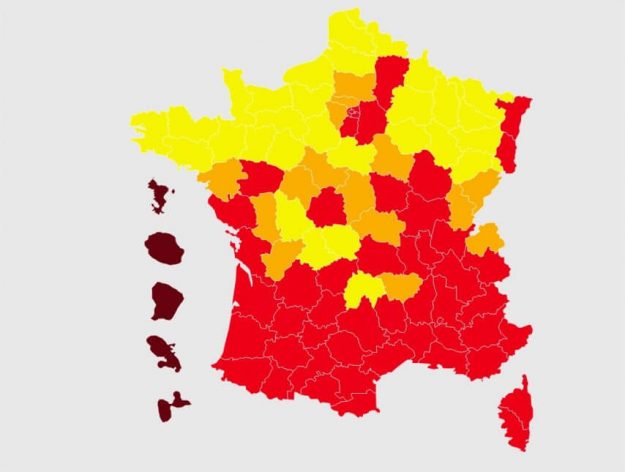Tiger Mosquito: Nine More Departments on Reg Alert, Three Quarters of the Country Affected

The tiger mosquito continues to grow in France. 51 departments have just been placed on red alert. 70% of the country is concerned by the presence of this insect.
The tiger mosquito infestation in France continues to escalate, with alarming consequences. Recent reports reveal that a staggering 51 departments have been placed on red alert, underscoring the widespread presence of this invasive insect. Shockingly, this means that approximately 70% of the country is now affected by the tiger mosquito. The growing menace of this species poses a significant threat to public health and necessitates immediate action.
Tiger Mosquito Distribution Map
The Mosquito Vigilance website has recently updated its map to provide an accurate depiction of the tiger mosquito’s presence across various departments in France. This comprehensive map serves as a vital tool for monitoring and understanding the extent of the infestation.

Dangers of the Tiger Mosquito
The tiger mosquito, scientifically known as Aedes albopictus, is a vector for several dangerous diseases. These include the Zika virus, chikungunya, and dengue fever. Originally imported from Asia via cargo ships, this invasive species has successfully established itself in France and is progressively advancing towards the northern regions of the country. The consequences of the tiger mosquito’s presence are far-reaching, posing significant health risks to the population.
| Disease | Description |
|---|---|
| Zika virus | The Zika virus can cause mild to severe symptoms, including fever, rash, joint pain, and conjunctivitis. In pregnant women, it can lead to birth defects in infants, such as microcephaly. |
| Chikungunya | Chikungunya causes fever, severe joint pain, muscle pain, headache, nausea, fatigue, and rash. The joint pain can be debilitating and may last for months or even years. |
| Dengue fever | Dengue fever is characterized by high fever, severe headache, pain behind the eyes, joint and muscle pain, rash, and mild bleeding. In severe cases, it can lead to dengue hemorrhagic fever or dengue shock syndrome, which can be fatal. |
Nine additional departments have been classified in red alert since Thursday 26th April 2019.
A total of 51 departments are now under threat:
|
|
Escalation of Infestation:
Since Thursday, April 26th, 2019, an additional nine departments have been classified under red alert status. This rapid expansion emphasizes the urgent need for effective measures to curb the spread of the tiger mosquito. Prompt action is necessary to mitigate the impact on public health and prevent further geographic advancement.
No department is spared
Unlike in previous years, no department is in green alert, ie the presence of the tiger mosquito is under surveillance or attested throughout France. The cause is to be sought because of particularly mild weather in recent months. Winter 2018-2019 was mild and even before the beginning of spring, the French experienced several very hot days, days favourable to the development of the small striped beast.
Read Also: Tiger Mosquito: Natural Repellents
How to identify a tiger mosquito?
The tiger mosquito measures an average of 0.5 cm, its abdomen and legs are black and white striped, very contrasted. Its wings are usually black. The tiger mosquito has a white line on the upper part of the thorax. It is not very mobile, and its flight is very slow, which makes it easy to crush. But unlike other mosquitoes, his flight is silent. Finally, be aware that its sting is more painful than that of the common mosquito and can cause pimples like blisters. Here are the main things to look out for:
- Size: The tiger mosquito measures an average of 0.5 cm, similar to the size of common mosquitoes.
- Black and White Stripes: The abdomen and legs of the tiger mosquito are adorned with distinctive black and white stripes, creating a high-contrast pattern.
- Black Wings: The wings of the tiger mosquito are usually black in colour.
- White Line on Thorax: There is a white line present on the upper part of the tiger mosquito’s thorax.
- Slow Flight: Unlike other mosquitoes, the tiger mosquito has a slow and deliberate flight pattern.
- Silent Flight: The flight of the tiger mosquito is silent, making it less noticeable compared to other buzzing mosquitoes.
- Painful Sting: The sting of the tiger mosquito is more painful compared to that of common mosquitoes and may cause pimple-like blisters.
By familiarizing oneself with these key identification features, individuals can better recognize the presence of tiger mosquitoes and take necessary precautions to protect against their bites.
It loves stagnant water
To prevent its proliferation, it is necessary to ban all stagnant water points in which It loves to land. Remember to empty all remaining cups in gardens, watering cans and other containers. Think of children’s toys that often hang out after a day of playing.
Enjoyed this? Get the week’s top France stories
One email every Sunday. Unsubscribe anytime.


